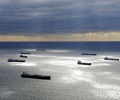Strait of Hormuz: The mystery of the disappearing tankers

This week, The New York Times recounted a strange phenomenon where an empty Chinese oil tanker recently entered the Gulf of Oman, rounded the Strait of Hormuz and then disappeared from the grid. A few days later, the same vessel appeared back on the grid, but this time it was lying lower in the sea, presumably full of oil, and was travelling out of the Strait of Hormuz and headed back to China.
The assumption is that the captain of the tanker had switched off his vessel’s signalling system, which is required to be left on at all times under international shipping rules, as he did not want it to be known that the vessel was collecting Iranian fuel, which is banned as part of global sanctions set in place by U.S. President Donald Trump since November.
This tactic, of ships appearing and disappearing at different times and in different places, is nothing new and has been taking place for a few months, say experts who monitor such practices, as tankers attempt to conceal the fact they are picking up Iranian oil supplies.
“It is a large scale phenomenon for Iranian exports… Most of the exports are done on the dark side,” said Dubai-based Giorgos Beleris, oil research manager for the Middle East and North Africa at Refinitiv.
While the tanker mentioned in The New York Times article was Chinese, Beleris said the majority of tankers taking part in such tactics and “going dark” are vessels which are part of the Iranian fleet.
“The oil itself is heading to China, that is correct, but not necessarily all Chinese [tankers]. What happens is Iran has a very big tanker fleet, one of the biggest, and they actually have the capacity to provide the transportation,” Beleris said.
“So a lot of the Iranian tankers are being used. We have seen some Chinese tankers,” he added.
Stockholm-based Samir Madani, co-founder of TankerTrackers.com, a company which uses satellite imagery to track tankers around the globe, said the trend for tankers going off grid was “the rule rather than the exception” when it comes to Iranian oil exports.
He said that their records show that the tankers also often reappear in the Suez Canal, shipping Iranian oil to Syria.
“Most of it is for China and Syria, Syria takes a small amount,” he said.
Drop in supply
Despite this, Madani and Beleris both pointed out that the number of ships using this tactic to pick up Iranian crude had “dropped significantly” in recent months.
Beleris said it was tracking an average of about 17 to 22 tankers per month, but that has now dropped from a high of 38 in January to just six in June.
“It has fallen drastically in the last six months because the volume of Iranian exports has declined, as obviously there is not that many buyers anymore,” he said.
Washington reintroduced sanctions on Iranian oil in November 2018. In May, Reuters reported that a tanker carrying Iranian fuel oil had unloaded its cargo at a Chinese port, violating U.S. sanctions.
In late June, Brian Hook, the U.S. special envoy for Iran, told reporters in London that Washington would sanction any country that imports Iranian oil.
However, speaking in Vienna last week, a Chinese official was described as ‘guarded’ when asked if the country was buying Iranian oil.
“We reject the unilateral imposition of sanctions and for us energy security is important,” Fu Cong, director general of the Department of Arms Control of the Chinese Foreign Ministry told reporters.
“We do not accept this zero policy of the United States,” he said when asked if China would buy Iranian oil.
Source: Arabian Business

 Hellenic Shipping News Worldwide Hellenic Shipping News Worldwide, Online Daily Newspaper on Hellenic and International Shipping
Hellenic Shipping News Worldwide Hellenic Shipping News Worldwide, Online Daily Newspaper on Hellenic and International Shipping























 PG-Software
PG-Software